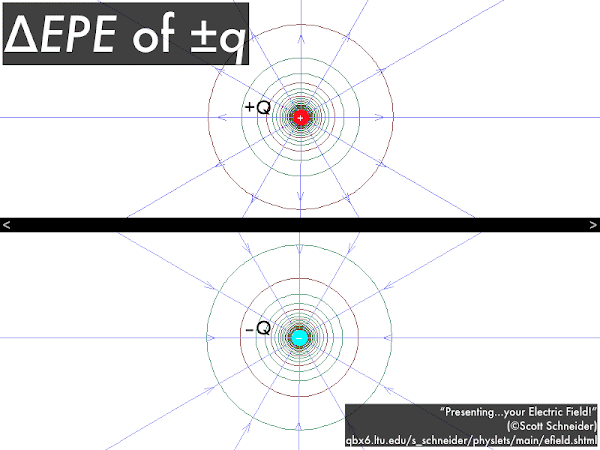Cuesta College, San Luis Obispo, CA
Students have a bi-weekly online reading assignment (hosted by SurveyMonkey.com), where they answer questions based on reading their textbook, material covered in previous lectures, opinion questions, and/or asking (anonymous) questions or making (anonymous) comments. Full credit is given for completing the online reading assignment before next week's lecture, regardless if whether their answers are correct/incorrect. Selected results/questions/comments are addressed by the instructor at the start of the following lecture.
The following questions were asked on reading textbook chapters and previewing presentations on electric potential energy.

Selected/edited responses are given below.
Describe what you understand from the assigned textbook reading or presentation preview. Your description (2-3 sentences) should specifically demonstrate your level of understanding.
"Voltage increases +∞ with decreased proximity to a positive source charge, and voltage decreases to –∞ with proximity to a negative source charge. EPE increases when two like charges are brought nearer or when two opposite charges are put farther apart, and decreased when two like charges are distanced and when two opposite charges are brought nearer."Describe what you found confusing from the assigned textbook reading or presentation preview. Your description (2-3 sentences) should specifically identify the concept(s) that you do not understand.
"There are two different approaches to analyze electric potential energy. In the direct approach we learned that we just analyze whether or not the source charge q1 exerts a force on, or stores EPE on test charge q2. The equation that is used for this is EPE = k·q1·q2/r. In the two-step approach to analyze how source charge Q creates a V potential around it, that then stores EPE with a test charge q. There are two separate equations for this method: in the first equation you determine the electric potential of the source charge Q; and then the second equation, use the magnitude of potential you calculated in the first step to find the value of electric potential energy of a test charge q."
"How to relate EPE to the potential energy forms we learned in 205A. Bringing two like charges together is like rolling a ball uphill; bringing opposite charges together is like letting it roll downhill. I understand that the electric potential is the energy per charge that is stored/needed to move a particle from point (A) to point (B)."
"Electrical potential, or voltage V is electric potential energy EPE divided by coulombs. Though V and EPE are not the same thing, they have a direct relationship."
"The use of the term 'potential' in the same sentence as 'potential energy.' Can we please, please call potential 'voltage?'"Explain the difference between the units of electric potential V, and electric potential energy, EPE.
"I found the two-step approach a lot more confusing. I also do not understand equipotentials. The real-life example of the guy on the snowmobile also did not make sense."
"How to tell whether EPE is increasing or decreasing based on changing the particle's position."
"Is EPE and potential V effectively the same thing?"
"I'm having difficulties for two-step approach for electric potential energy."
"The majority of the concepts here. I might be overthinking it."
"I'm sure there is something that I don't understand. We will see in class."
"Electric potential has units of joule/coulomb, otherwise known as volts, which is the electric potential energy per unit charge, while electric potential energy simply has units of joules."
"Volts vs. joules."
"They both consist of different measurements."
Explain the conceptual difference between the electric potential V, and electric potential energy, EPE.
"Electric potential is an energy per unit charge, while electric potential energy is an actual energy."
"V is when there is a two-step approach, so the source charge Q creates the V potential which is then multiplied by test charge q to get EPE."
"Electric potential energy is the amount of energy stored (or spent) to move a charged particle from one point in space to another. Electric potential is the amount of energy stored (or spent) per charge to move a particle in space from one point to another."
"Need some help on this one."
Briefly summarize the difference (if any) between "voltage" and electric potential.
"Since there's no difference I can leave this box blank, right?"
"There is no difference."
"Sort of nothing."

Identify the changes in electric potential energy EPE (if any) for the following test charges (±q):
(Only correct responses shown.)
Positive test charge +q brought closer to a positive source charge +Q: increase [58%]
Negative test charge –q brought closer to a positive source charge +Q: decrease [53%]
Positive test charge +q brought closer to a negative source charge –Q: decrease [64%]
Negative test charge –q brought closer to a positive source charge –Q: increase [61%]
Identify the changes in electric potential V (if any) for the following test charges (±q):
(Only correct responses shown.)
Positive test charge +q brought closer to a positive source charge +Q: increase [33%]
Negative test charge –q brought closer to a positive source charge +Q: increase [47%]
Positive test charge +q brought closer to a negative source charge –Q: decrease [50%]
Negative test charge –q brought closer to a positive source charge –Q: decrease [36%]
Ask the instructor an anonymous question, or make a comment. Selected questions/comments may be discussed in class.
"Your peak/well memory trick is awesome. If I answered any of the electric potential energy and voltage questions right it was only because of that."
"The snow was freaking epic on Sunday."
"I had a sip of coffee today for the first time in three days. It was either equivalent to or better than my first kiss." (Absence makes caffeine last longer.)
"Yeah, this is harder than the stuff from Friday."
"Is this just going to get more complicated?" (Yes, but we will start slowing down the pace when we get to the electric circuits and magnetic fields chapters.)"
No comments:
Post a Comment